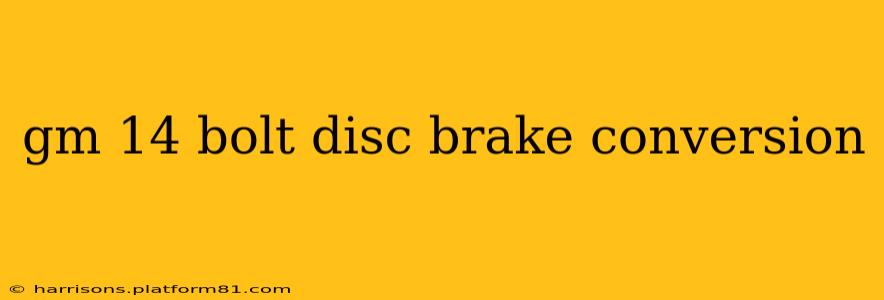The GM 14-bolt rear axle, a stalwart of heavy-duty trucks and SUVs, is known for its strength and durability. However, many owners find its drum brakes lacking in stopping power and modern feel. Upgrading to disc brakes significantly improves braking performance, offering better stopping power, fade resistance, and overall control. This comprehensive guide will delve into the process of converting your GM 14-bolt to disc brakes, covering various options and considerations.
Why Convert to Disc Brakes?
The benefits of converting your GM 14-bolt to disc brakes are substantial:
- Improved Stopping Power: Disc brakes offer significantly better stopping power than drum brakes, particularly in wet or muddy conditions. This enhanced braking performance translates to increased safety and control.
- Reduced Fade: Drum brakes are prone to brake fade under heavy use, leading to diminished stopping power. Disc brakes dissipate heat more effectively, reducing the likelihood of fade.
- Easier Maintenance: Disc brake maintenance is generally simpler than drum brake maintenance, requiring less frequent adjustments and servicing.
- Modern Feel: Upgrading to disc brakes provides a more modern and responsive braking feel, enhancing the overall driving experience.
- Increased Vehicle Value: A disc brake conversion can significantly enhance the value and desirability of your vehicle.
What are My Options for a GM 14-Bolt Disc Brake Conversion?
There are several approaches to converting your GM 14-bolt to disc brakes, each with its pros and cons:
- Complete Axle Assembly: Purchasing a complete 14-bolt axle assembly already equipped with disc brakes is the simplest option, although it can be expensive. This is often the preferred method if you are rebuilding the axle from the ground up.
- Conversion Kits: Numerous aftermarket companies offer conversion kits specifically designed for the GM 14-bolt. These kits typically include calipers, rotors, brackets, and necessary hardware. This is a popular choice for those wanting a DIY conversion.
- Custom Fabrication: For those with fabrication skills and experience, creating a custom disc brake conversion is an option, offering maximum customization and potentially cost savings. However, this demands a higher level of mechanical expertise and access to tools.
What Components Will I Need for a GM 14-Bolt Disc Brake Conversion Kit?
A typical GM 14-bolt disc brake conversion kit will include the following:
- Calipers: These are the clamping mechanisms that squeeze the brake pads against the rotors. Choose calipers appropriate for your vehicle's weight and intended use.
- Rotors: These are the discs that the calipers grip. Ensure the rotors are compatible with your chosen calipers and axle configuration.
- Brackets: These brackets mount the calipers to the axle housing. Proper fitment is crucial for optimal braking performance.
- Hardware: This includes mounting bolts, brake lines, and other miscellaneous fasteners.
- Brake Lines: These will need to be replaced or extended to accommodate the new caliper placement. Consider using stainless steel brake lines for enhanced durability.
- Parking Brake Mechanism: You'll need to incorporate a parking brake mechanism compatible with your chosen disc brake setup. This can range from a simple cable system to a more sophisticated electronically-actuated system.
H2: What about the E-Brake? How do I adapt it to disc brakes?
Integrating a parking brake into your disc brake conversion requires careful consideration. Most conversion kits provide a solution for this, but it might involve installing a cable-actuated system that engages the calipers directly, or using a separate drum-in-hat system integrated into one of the rotors. Check your kit's instructions carefully, or consult with a professional installer if you are uncertain about this step.
H2: What are the potential challenges of a 14-bolt disc brake conversion?
While a rewarding upgrade, a 14-bolt disc brake conversion does present some challenges:
- Wheel Backspacing: The larger disc brakes may require wheels with different backspacing to clear the calipers. Failing to account for this can lead to rubbing or damage.
- Brake Line Routing: Careful planning is required to route the brake lines correctly and securely to avoid interference with other components.
- Parking Brake Integration: Adapting a parking brake system to work with disc brakes can be complex. This is especially important for vehicles with integrated parking brakes into the rear hubs.
- Axle Housing Modification: In some cases, minor modifications to the axle housing may be required to accommodate the new braking components. This often involves drilling and tapping new mounting holes for the brake calipers.
H2: How much does a GM 14-bolt disc brake conversion cost?
The cost varies greatly depending on the chosen method. A complete axle assembly will be the most expensive, while a DIY conversion using a kit represents a more budget-friendly approach. Factor in the cost of parts, tools, labor (if hiring a professional), and any necessary modifications to the axle housing. Expect to budget from a few hundred dollars for a kit to potentially thousands for a complete assembly.
By carefully planning your conversion and addressing potential challenges, you can successfully upgrade your GM 14-bolt to disc brakes, resulting in enhanced stopping power, improved safety, and a more modern driving experience. Remember to consult your specific conversion kit instructions and consult with a professional mechanic if you are not comfortable with any of the steps involved.
